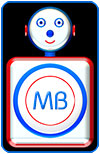
As I transfer and convert the MetronomeBot audio files to YouTube videos, I am thinking about all of the benefits of practicing with a metronome. Many students resist using a metronome, but it is one of the most useful tools we have to help us practice better. Here are several examples of how practicing with a metronome can be helpful to our musical growth and development.
The honest musical measuring stick. Can you imagine measuring the dimensions of a room without using a yard stick or measuring tape? You can always make a guess, but chances are very good that you are not going to get it right. The same applies to keeping a steady tempo with a metronome. There are so many things to be aware of while playing music that we can very easily take the tempo for granted. Without using a metronome to keep us honest in our practice, we are very likely to change the tempo without even realizing it. Here is a clue that can help you in your practice — if you are practicing with a metronome and it seems like the metronome is speeding up — it’s not! At that point, you are slowing down, but relative to what you are playing and feeling, it seems like the metronome is speeding up. A good metronome will never change tempos.
Slow and steady wins the race. Of course, playing music is not actually a race, but practicing slowly and accurately is one of the best ways to develop good fundamental technique on your instrument. By using a metronome to practice slowly, we can ensure that we don’t try to practice too fast, too soon. I confess that I have run into this problem in my own practice on more than one occasion — I’ll work on a difficult passage and begin practicing slowly and carefully, but if I don’t use a metronome to keep the tempo steady, I can very easily rush and make mistakes which can lead to bad habits. Practicing with a metronome enables us to work on a piece or a section of a piece at a slow tempo and nudge it up a little bit faster, one notch at a time.
Better sense of beat and tempo. Of course, another result of using a metronome is that if you practice carefully with it, your sense of beat will improve, and you will be able to keep a steady tempo more easily.
All of the above reasons apply to using a standard metronome that clicks on each beat. There are other specific metronome features that can help us improve even more. For example, if counting the beat is problematic for you, use a talking metronome. There are three talking metronomes in this site — ones that count in two, three, and four beats per measure. Also, subdividing metronomes are great for fine-tuning difficult rhythms and syncopation. There are three subdividing metronomes here that can be used for eighth notes, triplets, and sixteenth note patterns.
It should be noted that all of the above reasons for using a metronome are only valid if you listen carefully to the metronome while it is clicking, which brings us to the next benefit: practicing with a metronome improves your listening skills. It forces us to be aware of something other than what we are playing individually, and it is helpful in developing our ensemble skills, too.